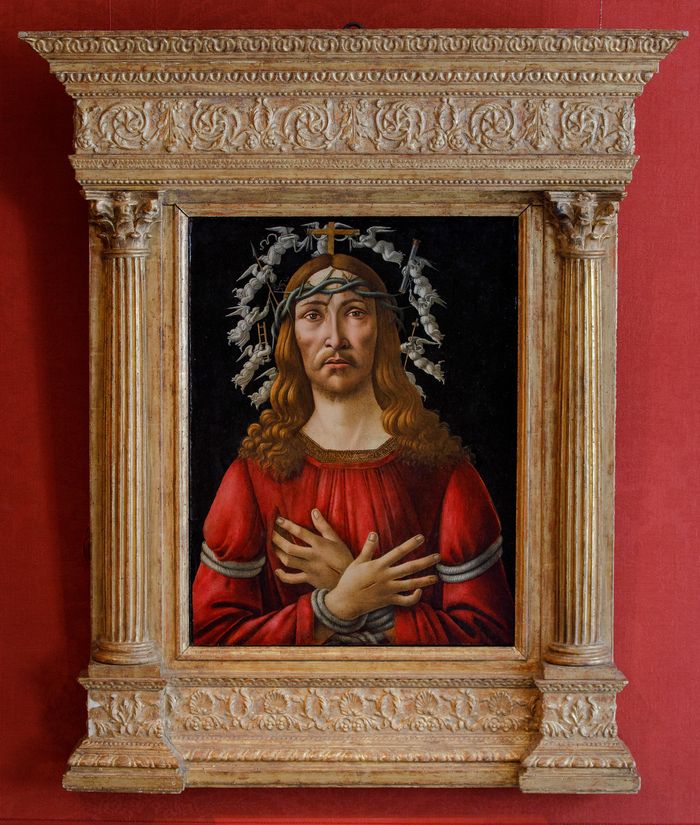A Sandro Botticelli portrait of Jesus Christ with bloodshot eyes and a halo of tiny, weeping angels sold for $45.4 million on Thursday in the latest sign of the art market’s resilience.
Sotheby’s in New York expected “The Man of Sorrows,” from around 1500, to sell for $40 million. Two phone bidders wound up competing for the work, with the auctioneer hammering the gavel at $39.3 million for a final sale price of $45.4 million including Sotheby’s commission.
The sale kicked off the art world’s spring season, continuing a hot streak that started last year as the world’s chief auction houses bounced back from the global pandemic with help from an influx of collectors eager for art trophies by household names.
Botticelli was a High Renaissance man from Florence who lived from 1445 to 1510 under the lush patronage of the Medici family, as well as the ascetic preaching of Dominican friar Girolamo Savonarola. His oeuvre reflects this aesthetic pendulum. Botticelli, a nickname that means “little barrel,” is best known for earlier, mythological scenes of goddesses in billowy gowns or perched nude atop seashells, as in “The Birth of Venus” and “Primavera,” both at the Uffizi Gallery.
His 1480 portrait of a “Young Man Holding a Roundel” caught attention more recently when Sotheby’s sold it for $92.2 million a year ago.

Botticelli‘s Christ in ‘The Man of Sorrows’ is in pain, bound by ropes and with hands already scarred by crucifixion, in contrast to Leonardo’s Christ in ‘Salvator Mundi.’
Photo: Sotheby’s
“The Man of Sorrows” reminds art lovers that the same artist later fell under the influence of Savonarola, whose rise and four-year dictatorship in Florence in the late 1400s cast a long shadow on the superstar artists working there at the time, including Botticelli and younger artists Michelangelo and Leonardo da Vinci.
Sotheby’s went to great lengths to compare Botticelli’s suffering Christ to the rediscovered painting of Christ by Leonardo, “Salvator Mundi.” Christie’s sold that painting to Saudi Arabia’s crown prince for $450.3 million in 2017, and it later hung in a royal yacht. Both painters likely worked on these portraits within months of each other, experts say. Both depict Christ as regal, though Leonardo shows his figure holding up a hand in a sign of blessing, while Botticelli shows his Christ in pain, bound by ropes and with hands already scarred by crucifixion.
“The ‘Salvator Mundi’ shows God as an icon, but Botticelli shows God in his humanity,” said Sotheby’s expert Christopher Apostle. “Botticelli’s version is less rigid, but it hits you in the face.”
SHARE YOUR THOUGHTS
What is your favorite Botticelli painting? Join the conversation below.
Botticelli’s Christ didn’t outsell Leonardo’s for complex reasons that likely have something to do with rarity—there are still four or five other Botticelli works in private hands, whereas surviving Leonardo works are more scarce—and with differing ownership histories. While “Salvator Mundi” was rediscovered after decades in obscurity and its authenticity hotly debated, Botticelli’s “Man” has been hidden away by the anonymous family that bought it for $28,000 in 1963, little seen but its origins recently unquestioned.
Mr. Apostle, who studied the work ahead of the sale, said Sotheby’s did discover something new about its Botticelli. Infrared tests reveal the artist initially started painting Christ as an infant, being hugged by his mother. But at some point, Botticelli turned the canvas upside down and started over, with this older Christ in mind.
Art Market
Write to Kelly Crow at [email protected]
Copyright ©2022 Dow Jones & Company, Inc. All Rights Reserved. 87990cbe856818d5eddac44c7b1cdeb8
Appeared in the January 28, 2022, print edition as ‘Botticelli’s Christ Sells for $45.4 Million.’








